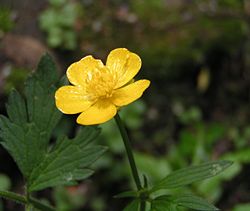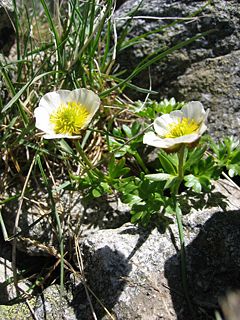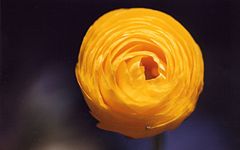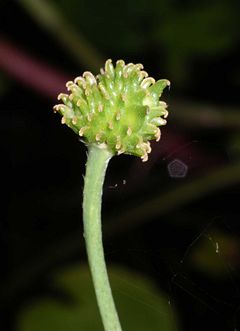Difference between revisions of "Buttercup" - New World Encyclopedia
Rick Swarts (talk | contribs) |
Rick Swarts (talk | contribs) |
||
| Line 18: | Line 18: | ||
over 400; see text | over 400; see text | ||
}} | }} | ||
| − | |||
| − | |||
| − | |||
| − | ''' | + | '''Buttercup''' is the common name for any of the members in the large plant [[genus]] '''''Ranunculus''''' in the [[flowering plant]] family [[Ranunculaceae]], typically characterized by glossy yellow or white flowers with a yellow center. The bright yellow flowers gave rise to the name buttercup, while the deeply toothed or lobed leaves have led to the name '''crowfoot''' also to be applied as a generally interchangeable common name for plants of this genus. A few species have orange or red flowers and occasionally, as in ''R. auricomus'', petals may be absent. |
| − | They are mostly [[herbaceous]] [[perennial plant|perennial]]s | + | There are more than 400 species in the ''Ranunculus'' genus, mainly native to temperate and cold regions. They are mostly [[herbaceous]] [[perennial plant|perennial]]s but some are [[Annual plant|annuals]] or [[Biennial plant|biennial]]s. |
==Description== | ==Description== | ||
| + | [[Image:Ranunculus glacialis.jpg|thumb|240px|''[[Ranunculus glacialis]]'', one of the white-flowering species]] | ||
| + | [[Image:Heart of gold.JPG|thumb|240px|Blooming outside [[Conservatory of Flowers]]]] | ||
| + | [[Image:Ranunculus achenes.jpg|thumb|240px||Seed head of Ranunculus showing developing achenes]] | ||
| + | The ''Ranunculus'' genus is part of the Ranunculaceae, a [[family (biology)|family]] of [[flowering plants]] also known as the "buttercup family" or "crowfoot family." The family name is derived from the genus ''Ranunculus''. Members include ''[[Anemone]]'' (anemones), ''Ranunculus'' (buttercups), ''[[Aconitum]]'' (aconite), and ''[[Clematis]]''. | ||
| − | + | Ranunculaceae are mostly herbaceous plants, with [[leaf|leaves]] that are often more or less palmately compound. The '''[[flower]]s''' of the ''Ranunculaceae'' are generally showy and medium to large in size in order to attract [[pollination syndrome|pollinators]]. | |
| − | |||
| − | |||
| − | |||
| − | Ranunculaceae are mostly herbaceous plants, | ||
| − | |||
| − | |||
| − | |||
| − | The '''[[flower]]s''' of the ''Ranunculaceae'' | ||
| − | |||
| − | |||
| + | ''Ranunculus'' is the largest genus in Ranunculaceae. In latin the name means "little frog," reflecting the fact that many of the plants in ''Ranunculus'' are aquatic plants. | ||
| − | The | + | The water crowfoots (''Ranunculus'' subgenus ''Batrachium''), which grow in still or running water, are sometimes treated in a separate genus ''Batrachium''. They have two different leaf types, thread-like leaves underwater and broader floating leaves although for some species, such as ''R. aquatilis'', a third, intermediate leaf form occurs. |
Buttercups usually flower in April or May but flowers may be found throughout the summer especially where the plants are growing as opportunistic colonisers, as in the case of garden weeds. | Buttercups usually flower in April or May but flowers may be found throughout the summer especially where the plants are growing as opportunistic colonisers, as in the case of garden weeds. | ||
Revision as of 19:54, 27 October 2007
| Ranunculus | ||||||||||||
|---|---|---|---|---|---|---|---|---|---|---|---|---|
 Creeping buttercup (Ranunculus repens)
| ||||||||||||
| Scientific classification | ||||||||||||
| ||||||||||||
|
over 400; see text |
Buttercup is the common name for any of the members in the large plant genus Ranunculus in the flowering plant family Ranunculaceae, typically characterized by glossy yellow or white flowers with a yellow center. The bright yellow flowers gave rise to the name buttercup, while the deeply toothed or lobed leaves have led to the name crowfoot also to be applied as a generally interchangeable common name for plants of this genus. A few species have orange or red flowers and occasionally, as in R. auricomus, petals may be absent.
There are more than 400 species in the Ranunculus genus, mainly native to temperate and cold regions. They are mostly herbaceous perennials but some are annuals or biennials.
Description
The Ranunculus genus is part of the Ranunculaceae, a family of flowering plants also known as the "buttercup family" or "crowfoot family." The family name is derived from the genus Ranunculus. Members include Anemone (anemones), Ranunculus (buttercups), Aconitum (aconite), and Clematis.
Ranunculaceae are mostly herbaceous plants, with leaves that are often more or less palmately compound. The flowers of the Ranunculaceae are generally showy and medium to large in size in order to attract pollinators.
Ranunculus is the largest genus in Ranunculaceae. In latin the name means "little frog," reflecting the fact that many of the plants in Ranunculus are aquatic plants.
The water crowfoots (Ranunculus subgenus Batrachium), which grow in still or running water, are sometimes treated in a separate genus Batrachium. They have two different leaf types, thread-like leaves underwater and broader floating leaves although for some species, such as R. aquatilis, a third, intermediate leaf form occurs.
Buttercups usually flower in April or May but flowers may be found throughout the summer especially where the plants are growing as opportunistic colonisers, as in the case of garden weeds.
All Ranunculus species are poisonous when eaten fresh by cattle, horses, and other livestock, but their acrid taste and the blistering of the mouth caused by their poison means they are usually left uneaten. Poisoning can occur where buttercups are abundant in overgrazed fields where little other edible plant growth is left, and the animals eat them out of desperation. Symptoms include bloody diarrhea, excessive salivation, colic, and severe blistering of the mucous membranes and gastrointestinal tract. When Ranunculus plants are handled, naturally occurring ranunculin is broken down to form protoanemonin, which is known to cause contact dermatitis in humans and care should therefore be exercised in excessive handling of the plants[1]. The toxins are degraded by drying, so hay containing dried buttercups is safe.
Ranunculus species are used as food plants by the larvae of some Lepidoptera species including Hebrew Character and Small Angle Shades.
Some species are popular ornamental flowers in horticulture, with many cultivars selected for large and brightly coloured flowers.
An old superstition says that if you hold a buttercup under your face, and yellow light is reflected on your face, it means that you like butter.
In the interior of the Pacific Northwest of the United States the buttercup is called ‘Coyote’s eyes’ — iceyéeyenm sílu in Nez Perce and spilyaynmí áčaš in Sahaptin. In the legend Coyote was tossing his eyes up in the air and catching them again when Eagle snatched them. Unable to see, Coyote made eyes from the buttercup.
Partial species list
- Ranunculus acraeus - a newly described species from Otago, New Zealand
- Ranunculus acris - Meadow buttercup
- Ranunculus alpestris
- Ranunculus aquatilis - Common water crowfoot
- Ranunculus arvensis - Corn buttercup
- Ranunculus asiaticus - Persian buttercup
- Ranunculus auricomus - Goldilocks buttercup
- Ranunculus bulbosus - Bulbous buttercup
- Ranunculus californicus - California buttercup
- Ranunculus cymbalaria - Marsh buttercup
- Ranunculus ficaria - Lesser celandine
- Ranunculus flamula - Lesser spearwort
- Ranunculus fluitans - River water crowfoot
- Ranunculus glaberrimus - Sagebrush buttercup
- Ranunculus glacialis - Glacier buttercup
- Ranunculus hispidus - Bristly buttercup
- Ranunculus lapponicus - Lapland buttercup
- Ranunculus lingua - Greater spearwort
- Ranunculus lyallii - Mount Cook Lily - reputedly the largest buttercup
- Ranunculus occidentalis - Western buttercup
- Ranunculus peltatus - Pond water crowfoot
- Ranunculus platanifolius - Large white buttercup
- Ranunculus pygmaeus - Pygmy buttercup
- Ranunculus repens - Creeping buttercup
- Ranunculus sardous - Sardinian buttercup
- Ranunculus sceleratus - Celery-leaved buttercup
- Ranunculus septentrionalis - Swamp buttercup
- Ranunculus sieboldii (ref. [2])
- Ranunculus testiculatus - Bur buttercup
and many more
Credits
New World Encyclopedia writers and editors rewrote and completed the Wikipedia article in accordance with New World Encyclopedia standards. This article abides by terms of the Creative Commons CC-by-sa 3.0 License (CC-by-sa), which may be used and disseminated with proper attribution. Credit is due under the terms of this license that can reference both the New World Encyclopedia contributors and the selfless volunteer contributors of the Wikimedia Foundation. To cite this article click here for a list of acceptable citing formats.The history of earlier contributions by wikipedians is accessible to researchers here:
The history of this article since it was imported to New World Encyclopedia:
Note: Some restrictions may apply to use of individual images which are separately licensed.



